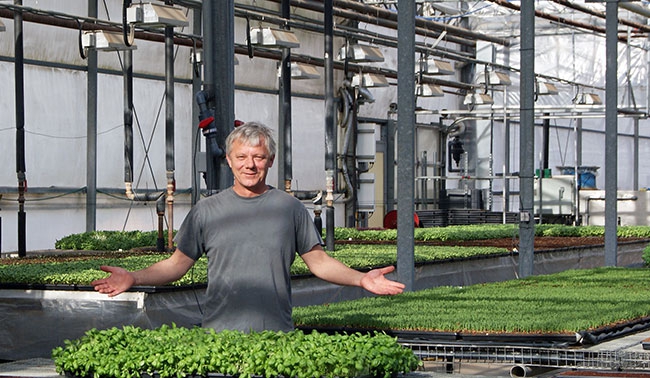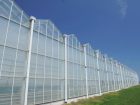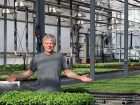
Features
Business
Management
GF2: A Great Program For Those with Plans to Innovate
Eligible greenhouse growers can reduce labour, water and energy costs through the popular Growing Forward 2, a popular five-year federal-provincial-territorial initiative.
December 12, 2016 By Lois Harris OSCIA
 Ian Adamson, owner of Greenbelt Greenhouse in Gormley, Ont.
Ian Adamson, owner of Greenbelt Greenhouse in Gormley, Ont. January 2017 – Ian Adamson, owner of Greenbelt Greenhouse, credits the Growing Forward 2 (GF2) program for helping him carefully examine his financial position and then significantly improve it by installing innovative packing equipment that increased productivity and his bottom line while decreasing water consumption in his operation.
GF2 is a five-year federal-provincial-territorial initiative designed to encourage innovation, competitiveness and market development in Canada’s agri-food and agri-products sector through cost-share funding opportunities. It was launched in 2013 and is delivered to farmers in Ontario by the Ontario Soil and Crop Improvement Association (OSCIA).
The next application intake period in Ontario is Feb. 3-23 of this year. Note: GF2 is national, but the
delivery to producers and growers differs somewhat across the provinces. Check with GF2 officials in your province for more information.
Adamson’s company – based in Gormley, Ontario – produces microgreens (plants like arugula, basil and broccoli that are picked when they’re still very young) for the restaurant and grocery markets.
“Because the plants are so tender, we needed equipment that had gentler washing, drying and handling than regular packaging systems,” he says. “We could not process our products fast enough to maintain quality as the product would deteriorate after harvest.”
IMPROVING PRODUCTION
With $100,000 in funding from GF2, Adamson had special equipment developed and manufactured in Germany. The system is unique in North America, which is how he received extra funding from the program for innovation. With it, his operation can now process 10 times the product with a quarter of the labour.
“This has not decreased our need for labour as our sales have more than doubled since the installation,” he says. Adamson also points out that his water usage is less than a quarter of what it used to be because now the water is filtered, treated and recycled.
In addition, the equipment had a lot to do with the operation becoming GAP (Good Agricultural Practices) certified for food safety, since it’s designed to be cleaned easily.
CONSIDERABLE INTEREST IN GF2 PROGRAM
In the first two years of the program, GF2 funded more than 1,700 projects with a government cost-share of about $17.7 million. An additional $7.4 million was allocated through a special program to deal with the porcine epidemic diarrhea virus.
In year three, 700 more projects received $8.6 million for which claims are still being processed. Over the three years, about $79 million has been invested in Ontario’s agriculture industry by producers and government.
Program funding is also available for education and training courses, marketing and a whole host of other improvements. There are over 40 different project categories from which to choose.
Here’s an overview of just some of the many areas for which greenhouse growers can apply under GF2. Full details of eligibility criteria are available through the GF2 program guide.
BUSINESS AND LEADERSHIP DEVELOPMENT
Farm Financial Assessments: “We started with GF2 to assist with, first, understanding our business’s financial position, and then gaining an in-depth understanding of the cost of production,” Adamson says. “This, in turn, steers analysis of what products and processes need improvement to achieve higher margins.”
To qualify for funding under this category, growers must have completed the Growing Your Farm Profits (GYFP) workshop or an equivalent within the past five years.
Eligible activities include hiring a consultant to assess the operation’s finances and costs of production. It also covers costs for data gathering and analysis, writing the report and reviewing the report with the grower.
Funding of up to 50 per cent of project costs are available to a maximum of $2,500.
Business plans: GF2 has funding available to develop business plans, succession plans, human resource plans, feasibility plans, expansion plans and diversification plans.
Eligible costs include paying for an advisor to develop the plan, as well as costs associated with putting the plan into action, including necessary documents (e.g. purchase and sales agreements, wills as they relate to succession plans, and shareholder agreements). GF2 also helps cover costs for specialized contracts, licensing agreements, the initial set-up of a management system and certification that increases market access (e.g. ISO, organic) as it relates to activating the business plan.
Funding is available at up to 50 per cent to a maximum of $10,000.
Labour productivity: As shown in the Greenbelt Greenhouse operation, improving efficiency through increased employee productivity and automation decreases costs and increases bottom lines. To receive funding under this category, growers must have completed the Grow Your Farm Profits (GYFP) workshop and developed an action plan in the last five years or done equivalent training and planning.
Assessments and plans: Growers can apply for funding to have productivity assessment done to reduce waste and decrease downtime for employees. Included among eligible expenses are benchmarking, data gathering and analysis and report writing. Funding is available at up to 50 per cent of project costs to a maximum of $2,500.
Funding is also available to defray the costs of developing a plan that identifies ways to increase productivity through increasing employee skills and upgraded or new equipment and technology. Up to 50 per cent of project costs are available to a maximum of $10,000.
Installing equipment/technology: Growers can apply for funding to put in place technology or equipment that will improve productivity in the operation. In addition to having completed a GYFP workshop in the last five years, applicants need to have a productivity plan showing how installing the equipment/technology will improve labour productivity.
Among the activities that are eligible are:
- Retrofit, upgrade or buy new equipment to increase automation.
- Modify existing equipment to increase efficiencies and save labour costs.
- Pay for advisory services to train employees on new equipment and/or technology.
- Pay for advisory costs to develop and translate policies, maintenance procedures and standard operating procedures (SOPs).
Funding is available up to 35 per cent of project costs to a maximum of $30,000.
ENVIRONMENT AND CLIMATE CHANGE ADAPTATION
Water Protection – Nutrient Recovery: The Greenbelt Greenhouse example shows that recovering nutrients from wash water or irrigation systems helps protect the environment and reduce operational costs for greenhouse growers. Applicants in this category need to have completed a third or fourth edition Environmental Farm Plan (EFP) within the past five years.
Eligible activities include modifying existing irrigation systems to recycle water and recover nutrients (collection, storage, transfer and treatment) and putting in place systems to recover wastewater from washing to recover nutrients. Constructed wetlands and other similar structures must be designed by a professional engineer. Producers can also get up to 50 per cent cost-share under project category A.0.2 Planning, to complete abatement or wastewater management plans up to a maximum of $5,000.
Funding is available for up to 35 per cent of project costs to a maximum of $30,000.
ENERGY AUDITS
The efficient use of energy resources saves money for growers and benefits the environment. For this category, growers must have completed a third or fourth edition Environmental Farm Plan within the past five years. Eligible activities include paying for qualified consultants to conduct energy-use assessments including a greenhouse survey and inspection, thermal imaging, data analysis, report preparation and review of the audit with the grower.
Funding of up to 50 per cent of project costs are available to a maximum of $5,000.
Growers should consult the GF2 Program Guide for full details.
What do growers need to apply to GF2 (see program guide for full details)?
- Have a farm business that’s a legal entity.
- Produce agricultural commodities in Ontario.
- File business and/or farm income/loss taxes in Ontario.
- Have a valid and up-to-date Premises Identification Number (PIN) for the farm property where the proposed project is taking place.
- Have a valid Farm Business Registration Number (FBRN) or an equivalent.
Only proposed projects with the highest merit or biggest impact will receive cost-share funding. That means the project must address a demonstrated need or business improvement. Criteria are specific to each project category. See Appendix 2 of the program guide.
Ian Adamson’s GF2 advice to growers:
- Find a good consultant to analyze your financial position.
- Perform an in-depth cost of production analysis.
- Plan for improvements to your process.
- Implement the improvements to processes and procedures.
The Ontario Soil and Crop Improvement Association (OSCIA) is a unique non-profit farm organization that represents all commodity groups across the province. It is a leader in producer education, local association development, program delivery and consumer outreach. www.ontariosoilcrop.org.
Print this page

